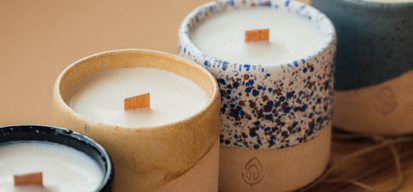How to calculate fragrance load when making candles
If you are considering adding fragrances to your candles, this article will cover everything you will need to know about fragrance oils and the percentage you will need to use in your candle blend.

If you are considering adding fragrances to your candles, it’s important to know that there are tried and tested formulae and calculations that are commonly used by professional candlemakers in order to create reliable and predictable results. Not having a firm grasp of these concepts can result in candles that have a weak or overpowering smell, or even produce a candle with poor wax / burn quality.
Knowing and applying these principles significantly increases the quality of your candle products, so let’s get learning!
Need to get your material and product inventory under control?
Try Craftybase - the inventory solution for candlemakers. Track raw materials and product stock levels (in real time!), lot and batch tracking, COGS, pricing / margin guidance and much more.
It's your candlemaking production central.
What is a “fragrance load”?
Before getting started, some key definitions you will need to know include:
Fragrance load — fragrance load is a term that indicates the percentage of fragrance you will need, in correlation to the amount of wax you will be using. Fragrance load is always expressed as a percentage.
Fragrance content — this is the proportion of fragrance used in the candle mixture.
Do note that the fragrance load and fragrance content are not interchangeable.
There is a huge range of fragrances available for candlemaking, from lavender to coral. As each different fragrance varies in physical properties like colour, density and flash point, every fragrance will affect your wax differently. Likewise, different waxes can have slightly different impacts on fragrances due to their gravity calculations.
Calculating the fragrance load
Firstly, you’ll want to note that fragrance load should be measured by weight, rather than by volume.
Before calculating your fragrance load, you will need to determine how much liquid wax your jar can hold. This should be measured either in ounces or grams: this is whatever measurement unit you use to manufacture your candle (as long as it is a weight measurement). Once you have measured out how much wax you will be using, you can then calculate the fragrance load.
The maximum fragrance load should depend on the wax. Typically, the percentage of fragrance load will vary between 5-6% however this will depend on the type of wax you are using to produce your candle. We’ll use typical wax averages for this calculation to keep things simple.
To find the weight of fragrance oil you will need to use, the formula is as such:

For example, if you have a wax weight of 320g and a fragrance load of 5%, the calculation would be:
5 ÷ 100 × 320 = 16g
The amount of fragrance oil you will thus need to use is 16g.
From here, finding out the exact amount of fragrance needed for your candle needs constant experimenting. Try starting with a fragrance load via the calculation above and use trial and error to see what works best for your candle.
What happens when you use too much fragrance?
Although wax can hold a fair amount of fragrance, it does not mean it should. Using too much fragrance can result in wax overload, creating various problems such as:
- Wick will barely achieve a flame
- Candle tunnelling
- Poor hot throw
- Dry or lumpy wax
If you do face these issues, lower your fragrance load and try again.
Final thoughts
Crafting a perfect candle takes time and experimenting — keep going until you strike a balance between wax and fragrance. If you are still unsure on the maths, there are various fragrance load calculators online for you to choose from.
Need to get your material and product inventory under control?
Try Craftybase - the inventory solution for candlemakers. Track raw materials and product stock levels (in real time!), lot and batch tracking, COGS, pricing / margin guidance and much more.
It's your candlemaking production central.
